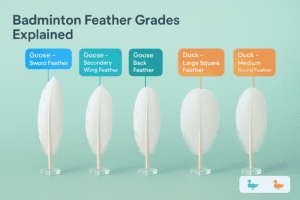Introduction
Choosing the right badminton string is crucial for optimizing your performance on the court. The type of string and its tension can significantly influence your control, power, and overall gameplay. In this comprehensive guide, we will cover everything you need to know about badminton strings, including different types, recommended tensions, and tips for maintaining your strings. Whether you’re a beginner or an advanced player, understanding these aspects will help you make informed decisions that enhance your game.
Understanding the Problem
Many players often overlook the importance of string selection, focusing primarily on their rackets. Research shows that approximately 60% of amateur players are unaware of how string type and tension can affect their performance. Common issues include:
- Inconsistent Shot Quality: Using the wrong string can lead to poor shot execution and control.
- Frequent String Breakage: Players may experience frequent breakages if they choose inappropriate string types or tensions.
- Lack of Knowledge: Many players simply do not know how to test or maintain their strings effectively.
By addressing these issues, you can significantly improve your gameplay and extend the life of your equipment.
Expert Insights / Solutions
1. Types of Badminton Strings
A. Badminton String Gauge (Thickness)
The thickness of badminton strings is measured in gauges, typically ranging from 0.61 mm to 0.74 mm. The gauge affects durability and playability:
- Thicker Strings (0.70 mm – 0.74 mm): More durable but offer less feel and control. Ideal for beginners or players using plastic shuttles.
- Example: Yonex BG3 (0.74 mm) is commonly used as a factory string.
- Medium Strings (0.68 mm – 0.70 mm): Offer a balance between durability and playability.
- Example: Yonex BG65Ti (0.70 mm) is popular among club players for its durability and all-round performance.
- Thinner Strings (0.61 mm – 0.66 mm): Provide excellent control and feel but are less durable.
- Example: Yonex BG66 Ultimax (0.65 mm) offers great repulsion and touch.
B. Badminton String Material
Strings can also vary in material, influencing their feel and performance:
- Nylon Strings: Commonly used for recreational play due to their affordability and durability.
- Multifilament Strings: Made from multiple strands, providing better comfort and power.
- Hybrid Strings: Combine two different types of strings for enhanced performance, such as Yonex’s Aerobite.
2. Choosing the Right String Tension
String tension plays a vital role in how your racket performs:
- Higher Tension (24 lbs and above): Offers more control and power but requires precise timing and technique to hit the sweet spot effectively.
- Lower Tension (below 24 lbs): Provides a larger sweet spot, making it more forgiving for beginners but may sacrifice some control.
Recommended Tensions by Skill Level
- Beginners: Generally should use lower tensions (around 20-24 lbs) to develop technique without the risk of frequent breakage.
- Intermediate Players: A tension range of 24-28 lbs is suitable as skills improve.
- Advanced Players: Higher tensions (28 lbs to 34 lbs) can be beneficial for those who can consistently hit the sweet spot.
3. Testing String Tension
Knowing how to test your string tension is crucial for maintaining optimal performance:
- Visual Inspection: Check if the strings appear tight; if they sag or move easily, they may need restringing.
- Feel Test: Gently press down on the strings; tighter strings will feel less flexible compared to looser ones.
- Sound Test: Striking the strings with a finger can produce different sounds based on tension; higher tension typically results in a sharper sound.
4. Maintenance Tips
To extend the life of your strings:
- Regular Restringing: Restring your racket based on usage—approximately every three months for recreational players or monthly for competitive players.
- Proper Storage: Keep your racket in a cool, dry place to prevent moisture damage to the strings.
- Avoid Excessive Tension: Do not exceed the manufacturer’s recommended maximum tension to avoid damaging your racket frame.
FAQs Section
Q1: How often should I restring my badminton racket?
A1: It’s recommended to restring every three months for recreational players; more frequent play may require monthly restringing.
Q2: What string tension should I start with as a beginner?
A2: Beginners should start with lower tensions around 20-24 lbs to allow for easier playability while developing skills.
Q3: Can I mix different types of strings on my racket?
A3: Yes, many players use hybrid setups with different string types for enhanced performance tailored to their playing style.
Conclusion
Understanding badminton strings—types, tensions, and maintenance—is essential for enhancing your performance on the court. By selecting the right string type that suits your playing style and keeping an eye on tension levels, you can significantly improve your game while extending the life of your equipment.
If you’re looking for high-quality badminton strings or equipment, visit badmintonsupplier.com today! Elevate your game with the right gear!







